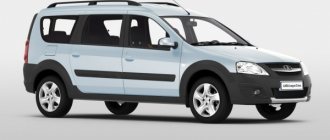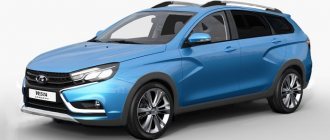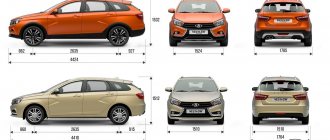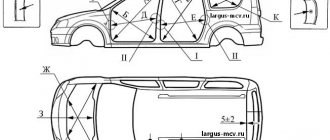Trends in the modern automotive market require the release of models that combine maneuverability and excellent cross-country ability. One of these cars was the new all-wheel drive Largus. A modified station wagon with crossover characteristics has won one of the leading positions in the ratings, making it into the top ten popular cars a few months after the official start of sales.
Exterior changes
The all-wheel drive Largus has been restyled, affecting mainly the front part of the car. The off-road profile was achieved through the applied facelift technologies:
- Side plastic body kits and inserts on wheel arches made of durable plastic protect the body from chips and scratches.
- Updated design of the radiator grille with the AvtoVAZ logo placed on it.
- 16-inch alloy wheels that improve the stability and handling of the crossover.
- New front bumper design and angular body lines.
Specifications
From a technical point of view, no special changes were made to the all-wheel drive Largus:
- Five-speed manual transmission. Provides smooth gear shifting and has a convenient digital mechanism.
- The brake system consists of two independent circuits, which, due to their diagonal arrangement, can replace each other in the event of failure.
- Easy to use cooling system.
The all-wheel drive Largus is equipped with a 16-valve engine with a capacity of 105 horsepower and a volume of 1.6 liters. It is paired with a five-speed transmission. The acceleration dynamics are 13 seconds. Maximum speed is 165 km/h, average fuel consumption is 9 liters per 100 kilometers.
The installation of new springs, silent blocks and struts made it possible to improve not only the handling, but also the technical characteristics of the Lada Largus Cross and ground clearance, which increased cross-country ability. The shock absorbers, brake system and steering were adjusted. The crossover is equipped with an ABS system.
The all-wheel drive Largus differs in size from the standard version: body length is 4.7 meters, width - 1.76 meters, height - 1.68 meters, wheelbase - 2.9 meters. The luggage compartment volume with the rear row of seats folded is 2350 liters. The manufacturer offers both 5-seater and 7-seater Lada Largus Cross.
Engine technical parameters
First, let's take a look at the car's engine. It is located transversely in the front part, which has long become a classic for domestic and world mechanical engineering. Details about the motor itself:
- engine brand K4M;
- 4 cylinders;
- working volume is 1600 cubic meters. cm;
- engine power is 102 hp. s., or 5750 rpm;
- torque is 3750 rpm.
So, the car is equipped with a really good engine, which is quite capable of satisfying the driver’s needs both in the city and on country roads. The maximum speed that this all-wheel drive vehicle can reach is 165 km/h. Acceleration from 0 to 100 km/h takes a little more than 13 seconds. We can say that for its class the car demonstrates good technical and dynamic characteristics. Of course, you won’t break speed records with it, but you will feel confident in the traffic.
Interior
Official dealers, as we have already said, offer the Lada Largus Cross for 5 seats and for 7 seats. The interior layout is in many ways reminiscent of the universal version of the crossover, equipped with comfortable wide seats, ergonomic controls and additional shelves for small items.
Changes in the interior design are visible to the naked eye: leather inserts in bright colors have appeared on the center console and door panels, all seats are equipped with comfortable headrests. There are three-point seat belts. The design of the driver's seat is equipped with lumbar support. The steering wheel can be adjusted to its maximum vertical position.
The safety system of the all-wheel drive Largus is similar to that on European cars and is represented by airbags for the driver and front passenger, and side airbags that protect against injury in the event of a frontal collision.
Body and “filling” of the car
The Lada of this model has a rather stylish body, although some note some angularity in the rear. However, it looks quite organic, so this car can be called aesthetic and harmonious. Here are some
| Body characteristics | Peculiarities |
| A station wagon. It has the classic 5 doors for this type. | Sufficiently roomy trunk. |
| Trunk volume. | 560 cm cube |
| There are 5 seats in the cabin, which can easily accommodate 7 people. | It is for its good carrying capacity and ability to transport a considerable number of passengers that this car is recognized as very practical and convenient. |
| The vehicle dimensions are as follows: 4470/1756/1682. | Largus looks a little long, but this can be called a feature of all station wagons. This feature does not in any way affect the ease of movement around the city; it is convenient to maneuver. |
| Machine weight. | Is approximately 1300 kg. |
| The car is available in different colors. | From metallic to blue and red. |
Comfort of movement
Regardless of the price and configuration, the Lada Largus Cross 4x4 is equipped with an independent front suspension and a semi-independent rear suspension, which ensures the comfort of the crossover:
- Elimination of outside noise while driving.
- Smooth ride when driving on uneven road surfaces.
- Increased passability on country roads.
- Maintains excellent handling and maneuverability in urban areas.
The reinforced body and frame increase the level of safety when driving at high speed.
Lada on methane
In Vesta, two cylinders are hidden under the raised floor.
They will create a bracket for the spare tire, but it will have to live in the trunk. In Vesta, two cylinders are hidden under the raised floor. They will create a bracket for the spare tire, but it will have to live in the trunk.
Why is it so expensive? The bulk of the cost is for cylinders. They are divided into four generations depending on the material and manufacturing technology. If relatively simple and cheap steel cylinders of the first generation are suitable for buses, then in passenger cars the cylinders should be as light as possible - and it is better to use plastic reinforced with carbon fiber. VAZ people think so, although the Volkswagen concern uses both composite and steel containers on different models.
On two fronts
Engineers tried modern cylinders only on Vesta. In fact, this is a prototype demonstrating what a gas-fueled car should ideally look like. The containers are hidden from view under the raised trunk floor in a redesigned niche where the spare tire is usually kept. The filling connector of the modern international standard ISO 14469-1 is located under the gas tank flap - after all, it’s not for nothing that the size of the latter offends the feelings of connoisseurs of beauty. But the main thing is that Vesta has a dual-fuel engine control controller, which ensures optimal operation on both one fuel and the other and an imperceptible transition from gasoline to gas and vice versa. The control unit was developed by the domestic company Itelma, which supplies the lion's share of electronics for Lada. Such a controller can be easily calibrated for a car with a robotic gearbox; it can be equipped with functions for simultaneous injection of gasoline and gas, which is required in certain modes.
Cargo dimensions
The restyled version of the all-wheel drive Largus is available in two versions - five- and seven-seater, differing in the interior layout and luggage compartment volume. Folding seats allow you to quickly transform the seven-seater model into an all-terrain station wagon with all-terrain capability and spaciousness. The crossover is equipped with powerful roof rails and an additional luggage basket. The ability to load large items is available thanks to the hinged rear doors.
The five-door design greatly facilitates access to the cabin for third-row passengers. The cargo model of the all-wheel drive Largus allows you to load items through the side door.
Configurations and prices of Lada Largus Cross 4x4
Official dealers offer two trim levels of the crossover, the price of which directly depends on the engine and option package. The restyled version of the crossover in the basic configuration is considered budget and is equipped with front-wheel drive.
A car with a five-seater configuration will cost motorists 674 thousand rubles. The version is equipped with a five-speed transmission and a 1.6-liter engine. The five-seat crossover option package includes the following:
- Front and side airbags, power steering column, leather steering wheel upholstery, wide steering column adjustment range.
- Fog lights, air filters, door moldings.
- On-board computer, ABS system, parking sensors.
- Electric windows, central locking.
- Standard audio system with USB and AUX connectors.
- Air conditioning, heated mirrors and front seats.
The seven-seater version of the Lada Largus Cross 4×4 is equipped with a third row of seats for two seats and is sold for 699 thousand rubles. Access to the third row is difficult even with the second row seats reclined. The interior is complemented with sporty elements.
The universal model is equipped with a heated windshield and rear-view mirrors, climate control, a multimedia system, fog lights, power accessories and heated all seats.
As an additional option for 6 thousand rubles, the ERA-GLONASS system and the color of the car body in any other shade are offered.
Lada on methane
In the cargo-passenger version of Largus, the cylinder is attached to the floor immediately behind the driver's seat.
In the cargo-passenger version of Largus, the cylinder is attached to the floor immediately behind the driver's seat.
Gazprom Gas Engine Fuel, a subsidiary of the fuel concern, is engaged in the comprehensive development of the natural gas consumer market in 49 regions of the country. Its areas of activity include the modernization of existing CNG filling stations and the construction of new stations, attraction of resources and assistance in optimizing the laws that regulate the gas engine market.
There are a lot of plans. According to the Ministry of Energy, the number of methane gas stations should double by 2022. Russian Government Decree No. 767‑r prescribes to significantly increase during this time the number of gas vehicles used in public transportation and municipal road works. In cities with a population of over a million, their share will be half of the vehicle fleet, in large (over 300 thousand inhabitants) municipalities - a third. For this purpose, subsidies are allocated annually: for example, when purchasing methane GAZelles and similar minibuses, the region is compensated 130 thousand rubles for each minibus, for a full-size LIAZ or MAZ - 1.3 million, for an accordion - 3 million. This not only covers the higher cost of methane buses compared to conventional ones, but even makes them more attractive!
“If we launch a similar subsidy mechanism for individuals, interest in passenger cars running on natural gas will increase sharply,” sighs Sergei Ivlev. — After all, a set of high-quality gas equipment (with installation) increases the cost of a car coming off the production line by 80–100 thousand rubles, and with the price of the same Vesta 534 thousand (we gasify the basic modification with air conditioning), this is a noticeable amount.











